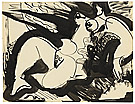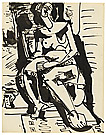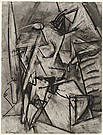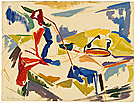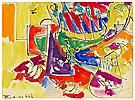America + Australia
Painters continued to work in an Abstract Expressionist style into the 1960s and 1970s, long after new tendencies such as Pop and Minimalism became dominant modes. The artists associated with Colour-field painting and the second-generation Abstract Expressionists increasingly exploited the qualities of paint. Their canvases are emphatically flat, or are made to achieve an ‘overall’ effect.
Abstract Expressionism was more than an American phenomenon, and the impact of influential painters was felt beyond the United States. Works by Australians such as Tony Tuckson and Peter Upward reveal how these artists developed in related ways. In his evocative and beautiful Watery c.1960, Tuckson spreads layers of pale paint and then ‘writes’ across the surface. Upward’s large, expressive gestures — his paint thickened with medium — seem to defy materiality and speak instead of calligraphy, jazz and poetry. By using enamel, artists such as Ralph Balson and Michael Taylor develop layer upon layer of thread-like paint.
The drawings, lithographs and collages on display here emphasise how artists exploit gesture and mark-making across a range of mediums. Willem de Kooning continued to refer to the human body throughout his long career. Glimpses of the figure remain, even in the 1980s, when he adopted a white ground for his marks, which seem to glide over the surface.


